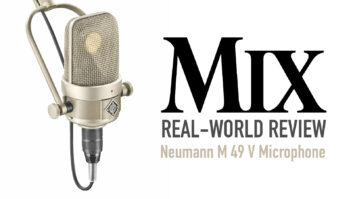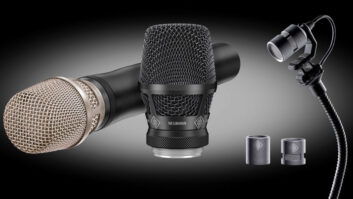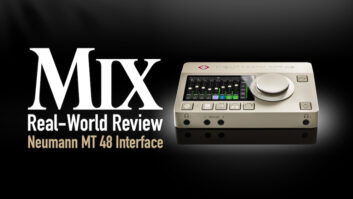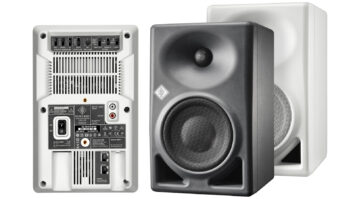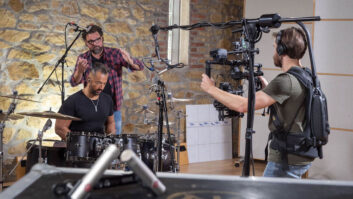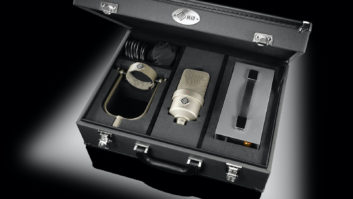The TLM 127 is the latest FET 100 Series mic in Neumann’s
transformerless microphone line (TLM). Available in either black matte
or Neumann’s trademark nickel finish, the side-address TLM 127
starts out with the K 127 large dual-diaphragm capsule, which is based
on the K 103 used in the TLM 103. The membrane thickness is 6
microns.
On the back of the mic is a -14dB attenuator pad (which takes the mic’s
140dB SPL handling to a hefty 154 dB) and a two-position highpass filter. The filter’s LIN (linear)
setting is a 12dB/octave roll-off starting at 15 Hz for wind noise,
handling and mic stand vibrations. The other position moves the corner
frequency up to 100 Hz and is good for proximity effect reduction or just boomy sound
sources.
A three-position pattern switch selects cardioid, omnidirectional and “R” (remote
pattern control) mode over a standard XLR mic cable up to 300 meters long. Accessing the
mic’s remote capabilities requires the optional N48 R-2,
Neumann’s special phantom power supply, which will power and control
up to two TLM 127s.
IN THE STUDIO
Compared (both in cardioid) to my stock U87, the 127 is a
flatter-sounding mic without the slightly low midrange buildup and
harder-sounding upper midrange of the U87. There is also a very smooth
high-frequency extension on the 127 where the U87 almost sounded rolled
off by comparison. I tested the mic in cardioid and omni modes, but
without the power supply, I couldn’t try my “two facing
out-of-phase guitar cabs with figure-8 mic in between” trick.
In a practical sense, the 127 behaved very much like the TLM 103 in
the studio, except the larger 127 does not fit quite as easily in tight
places around a drum kit. The The EA 1 shock-mount is a necessity in
all cases, as the 127 has terrific subsonic response. The mount will
take care of any external subsonics mechanically coupling and traveling
up the mic stand. This extended low-frequency response is great at
capturing all of the sounds from drums, bass instruments or the
“thump” from loud Marshall guitar cabinets.
The 100Hz roll-off position worked well for recording acoustic
guitars, where I put the 127 in cardioid two inches above the sound
hole—an “old-school” pop recording method that
minimizes fret noise pickup while delivering a consistent and loud
sound, albeit boomy. Fingerboard noise permitting, I usually end up
moving the mic up the neck a bit. Even though I would not normally use
a large-diaphragm mic for acoustics, the 127 sounded great on both
nylon- and steel-string guitars.
I also tried the 127 in omni about a foot away, again with the
roll-off engaged. The sound of the guitar “moved back” as
compared to cardioid but gained an open brilliancy. I liked this better
for transparent-sounding chord strumming than for flat-picking. With
this mic’s low noise floor (7 dBA), I could crank up the mic gain
without pulling up any mic noise or hum. Both of these methods produced
a bright and clear sound with a minimum of EQ or fuss.
I close-miked my Fender Concert guitar amp and got plenty of sparkle and thick bass. The
127 had more bass and less upper-midrange crankiness than the U87, but
more super-top that can get a little twangy if you want. In this case,
the mic placement helped, as I favored the outside of the speaker cone
away from the center. I had to use the -14dB pad, because the
127’s hot output in this high-SPL situation distorted my API
preamp.
For vocals in cardioid, the proximity effect can be an issue with a
mic this fat-sounding, and backing my singer off a foot away still
produced plenty of low-frequency “chestiness.” If your
singer loves to “kiss the mic,” then the 100Hz roll-off
position will combat bass buildup; but in this instance, I found the
filter a little high in frequency. I wish there was a second lower
position at 50 Hz.
The 127 is excellent for loud or soft singers. Loud singers who can
become edgy when singing in their upper registers will appreciate the
127’s smooth top end that doesn’t exacerbate this typical
problem. Soft singers will notice a sensitivity and clarity that helps
with lyric articulation.
The TLM 127 also opens up the option of omnidirectional vocal
recording. In omni, there is no more proximity effect, so my singer
could work around the mic without having to deal with tonality change.
In the omni position, I encountered much less “beaming
effect,” where the high frequencies can drop off in cardioid if
the singer turns slightly off of the mic’s direction. In omni,
the 127 had a more airy sound and pulled in more room tone around the
voice. For the blues/rock tune we recorded, it worked well with very
little need for additional reverb or delay.
TODAY’S WORKHORSE
The TLM 127 is an excellent-sounding utilitarian studio mic. It comes
in two kits: TLM127/SET Z with EA 1 elastic suspension mount and cherry
box at $2,149.99, and the lower-cost TLM127/SET A with an SG 1 (same
basic mount as TLM 103) and cardboard box at $1,799.99. The N48 R-2
power supply/remote controller will sell for $1,015 when it becomes
available.
Neumann, www.neumannusa.com
